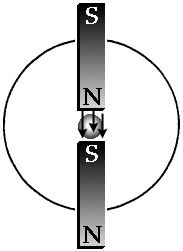 Magnetic field produced at oscilloscope
screen by students using
two bar magnets:
Magnetic field produced at oscilloscope
screen by students using
two bar magnets:
There is an electron beam in the oscilloscope that moves in a nearly straight line from back to front, as a result of a potential difference of tens of thousands of volts. To show how a magnetic field can deflect a beam of charged particles, set an oscilloscope to produce a well-focused spot near the center of the screen. Position the north pole of one bar magnet directly above the beam of the oscilloscope, and position the south pole of another magnet directly below the beam as shown here. (Be careful to avoid bumping or scratching the screen with the magnets.)
 Magnetic field produced at oscilloscope
screen by students using
two bar magnets:
Magnetic field produced at oscilloscope
screen by students using
two bar magnets:
Explain the direction in which the beam is deflected.
By using C-shaped magnets (as shown below) placed regularly around the beam pipe of a circular accelerator, physicists are able to continuously bend a particle beam through a near-circular path.
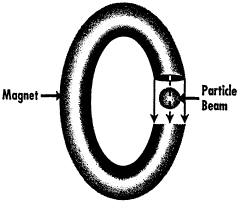 Particle beam within the magnetic field
of a C-shape magnet
Particle beam within the magnetic field
of a C-shape magnet
Next, you can demonstrate how a magnetic field can focus
a beam of charged particles by setting an oscilloscope to
produce an unfocused beam (turn the focus knob until the
spot on the screen is as large as possible). An unfocused
beam results in a large spot on the screen, as shown at top
right. In particle accelerators, unfocused beams are
undesirable because they result in low rates of collisions
between beam particles.
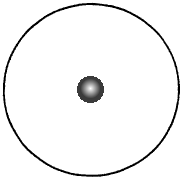 Unfocused oscilloscope without magnets
Unfocused oscilloscope without magnets
Place a bar magnet (with the north pole up) against
the oscilloscope screen and to the left of the beam (as
shown below). Then place another bar magnet with the north
pole down against the oscilloscope screen and to the right of
the beam. The spot on the screen should now be vertically
compressed and horizontally expanded.
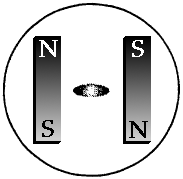 Unfocused oscilloscope with magnets
Unfocused oscilloscope with magnets
Try to visualize the situation you've just set up by looking at the next diagram and using the "left-hand rule" (the beam is negative).
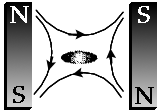
The arrangement of magnets you've just used is called a quadrupole. As you've seen, one quadrupole arrangement will improve the focus of a particle beam in one direction, and worsen it in the perpendicular direction. By using two quadrupole arrangements with the right spacing along the beam path -- and one set rotated 90 relative to the other -- it is possible to improve the overall focus of a particle beam. This is how physicists improve the focus of beams in particle accelerators.